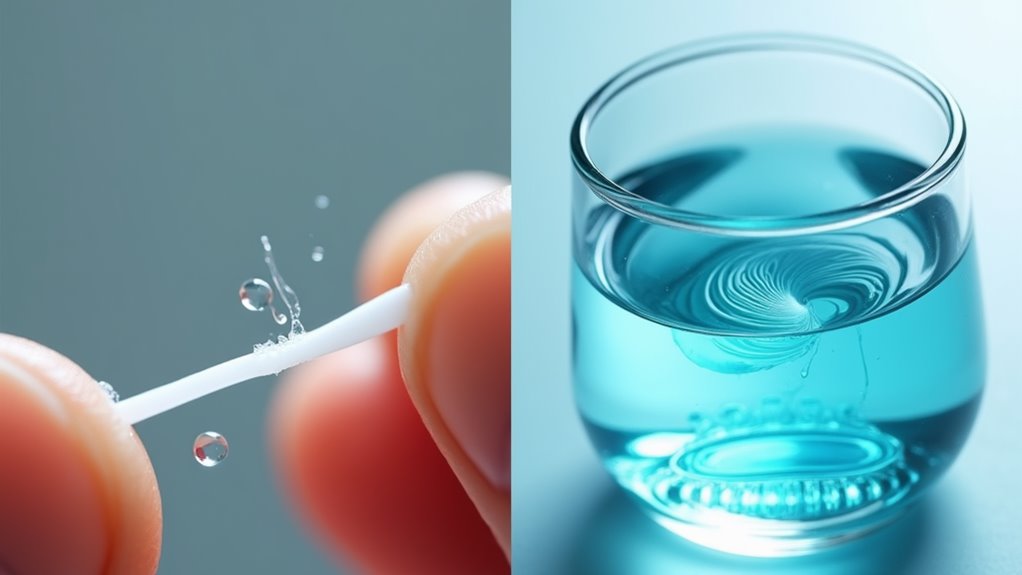Flossing or Mouthwash. The Answer Will Surprise You!
You’ve probably heard conflicting advice about whether to prioritize flossing or mouthwash in your daily routine. While both play important roles in oral health, one method stands out for its ability to protect your teeth and gums. The surprising truth is that your choice between these dental care options can significantly impact your long-term oral health – and the science behind it might change how you think about your daily dental routine.
The Science Behind Flossing vs. Mouthwash
While both flossing and mouthwash aim to improve oral health, they work through distinctly different mechanisms.
Flossing relies on mechanical action to physically remove plaque, food particles, and bacteria from between your teeth and along the gumline. It’s like having a tiny cleaning crew that reaches spaces your toothbrush can’t access.
Mouthwash, on the other hand, uses chemical compounds to combat oral bacteria and freshen breath. The antimicrobial agents in therapeutic mouthwashes can reduce plaque formation and gingivitis, while fluoride-containing varieties help prevent tooth decay. However, they can’t remove existing plaque buildup.
In the flossing vs mouthwash debate, research shows that flossing provides superior interproximal cleaning and biofilm disruption. Proper technique is essential for maximizing the benefits of flossing and preventing gum damage.
While mouthwash can reach all oral surfaces, it lacks the mechanical capability to dislodge stubborn debris. Think of flossing as your primary defense, with mouthwash serving as a powerful supplement to your oral care routine.
Real Benefits of Daily Flossing Revealed
Regular flossing delivers powerful health benefits that extend far beyond simply removing trapped food.
You’ll significantly reduce your risk of gum disease, tooth decay, and bad breath by breaking up bacterial colonies that thrive between teeth. Research shows that daily flossing decreases inflammation throughout your body, potentially lowering your risk of heart disease and diabetes.
What’s particularly innovative about flossing is how it accesses the 35% of tooth surfaces that brushing alone can’t reach.
When you floss correctly, you’re disrupting biofilm formation – the sticky matrix where harmful bacteria multiply. The mechanical action stimulates blood flow to your gums, promoting healing and strengthening the tissue’s natural defense mechanisms.
You’ll notice immediate benefits like fresher breath and healthier-looking gums within two weeks of consistent flossing. Additionally, exploring alternatives to flossing can help diversify your oral hygiene routine and maintain gum health effectively.
Long-term, you’re investing in a future with fewer dental procedures, stronger teeth, and better overall health.
Best Practices for Combining Both Methods
Since both flossing and mouthwash offer unique benefits, combining them strategically maximizes your oral health routine.
You’ll get superior results by following a specific sequence that leverages the strengths of each method while amplifying their collective impact.
-
Start with thorough flossing to dislodge food particles and plaque between teeth, creating clear pathways for the mouthwash to penetrate effectively.
-
Brush your teeth immediately after flossing to remove the loosened debris and apply fluoride from your toothpaste to newly exposed surfaces.
-
Wait 30 minutes before using an antimicrobial mouthwash to allow the fluoride from your toothpaste to fully interact with your enamel.
-
Swish with mouthwash for a full 60 seconds, ensuring it reaches all areas where you’ve just flossed, maximizing its bacteria-fighting properties. This is particularly important as alcohol content in mouthwash can lead to dry mouth if used excessively.
This advanced approach creates a synergistic effect that’s significantly more effective than using either method alone.




